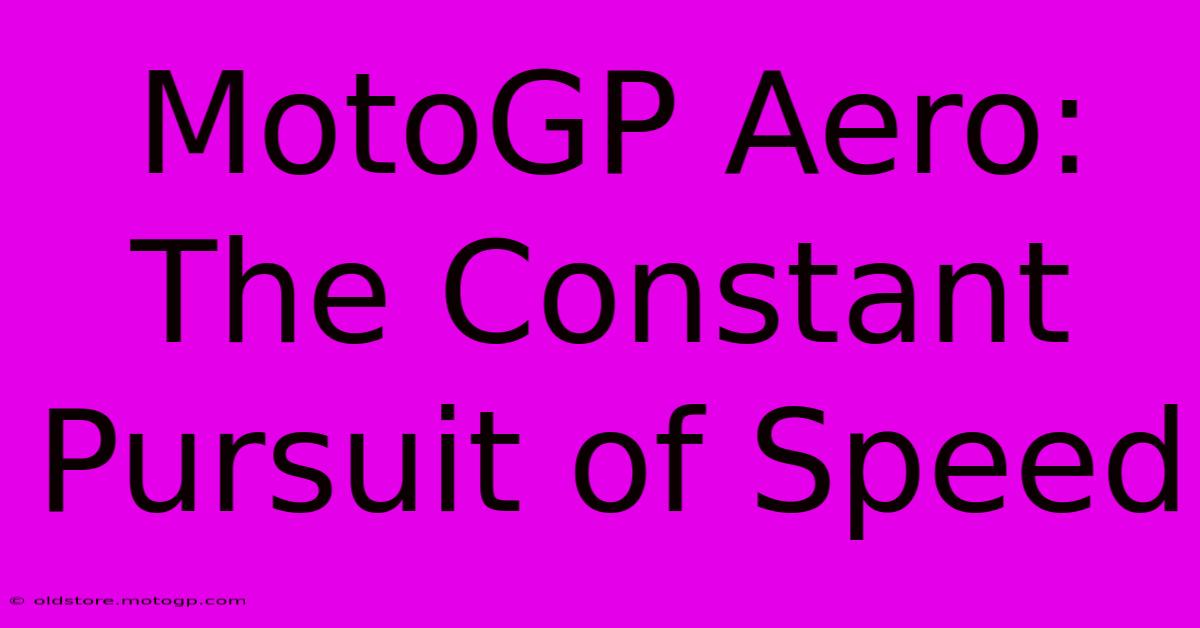MotoGP Aero: The Constant Pursuit Of Speed

Table of Contents
MotoGP Aero: The Constant Pursuit of Speed
The roar of the engines, the smell of burning rubber, the breathtaking speeds – MotoGP is a spectacle of raw power and precision. But beneath the surface of thrilling races and daring overtakes lies a constant battle for aerodynamic advantage. MotoGP aero isn't just about looking cool; it's a crucial element determining victory and defeat. This article delves into the fascinating world of MotoGP aerodynamics, exploring its evolution, impact, and the relentless pursuit of speed it fuels.
The Science of Speed: Understanding MotoGP Aerodynamics
MotoGP bikes, unlike their road-going counterparts, are meticulously designed to maximize downforce and minimize drag. This delicate balance is achieved through a complex interplay of various aerodynamic components:
Wings and Winglets:
These are perhaps the most visible elements of MotoGP aero. Winglets, smaller aerodynamic surfaces, generate downforce, pressing the bike to the track for improved cornering stability at high speeds. Larger wings, often found at the front and rear, contribute significantly to this downforce, allowing riders to brake later and harder into corners. The design and placement of these wings are constantly refined, with teams experimenting with different configurations to optimize performance for specific tracks.
Fairings and Bodywork:
The motorcycle's fairing and bodywork play a crucial role in streamlining airflow. The design minimizes drag, allowing the bike to reach higher top speeds on straights. Simultaneously, carefully sculpted surfaces channel air to generate downforce, enhancing stability. Even small changes to the fairing's shape can significantly impact performance. Computational fluid dynamics (CFD) is heavily used to simulate airflow and optimize these designs.
The Rider's Role:
The rider isn't just a passenger; they're an integral part of the aerodynamic system. Their body position, tucked in for maximum streamlining or slightly altered to adjust downforce distribution, subtly influences the bike's aerodynamics. Experienced riders understand how to manipulate their body to optimize performance in various racing conditions.
The Evolution of MotoGP Aero: From Simple to Sophisticated
MotoGP aero has come a long way. Early bikes lacked the sophisticated aerodynamic aids we see today. The evolution has been driven by the relentless pursuit of marginal gains:
- Early Days: Basic fairings primarily focused on streamlining.
- The Rise of Winglets: The introduction of winglets marked a significant shift, dramatically improving cornering stability.
- Sophisticated Wing Designs: Modern MotoGP bikes boast complex wing designs, incorporating numerous small elements to fine-tune airflow and maximize downforce.
- Continuous Refinement: Teams constantly experiment with new materials and designs, seeking even the smallest improvements in performance. This constant innovation is a key characteristic of MotoGP's competitive landscape.
The Impact of MotoGP Aero on Racing
The impact of advanced aerodynamics on MotoGP racing is undeniable:
- Higher Cornering Speeds: Increased downforce allows riders to carry significantly higher speeds through corners, leading to faster lap times.
- Improved Braking Performance: Downforce improves stability during braking, allowing riders to brake later and harder, further shaving off precious seconds.
- Enhanced Stability: The bike is more stable at high speeds, improving rider confidence and control.
- Strategic Advantages: Different aerodynamic configurations can be optimized for specific track characteristics, giving teams a strategic advantage.
The Future of MotoGP Aero: What Lies Ahead?
The pursuit of aerodynamic perfection is never-ending. Future developments may include:
- More Sophisticated Materials: The use of lighter, stronger, and more aerodynamically efficient materials will continue to push the boundaries of performance.
- Adaptive Aerodynamics: Imagine wings that adjust their angle and shape in real-time based on the bike's speed and cornering forces. This technology could significantly enhance performance.
- Improved CFD and Simulation: Advances in computational fluid dynamics will allow for even more precise and efficient aerodynamic designs.
MotoGP aero is a constant push and pull, a battle between maximizing downforce and minimizing drag. It is a testament to human ingenuity and the relentless pursuit of speed, a pursuit that captivates millions and defines the electrifying spectacle that is MotoGP. The constant refinement and innovation in this area will undoubtedly continue to shape the future of motorcycle racing.

Thank you for visiting our website wich cover about MotoGP Aero: The Constant Pursuit Of Speed. We hope the information provided has been useful to you. Feel free to contact us if you have any questions or need further assistance. See you next time and dont miss to bookmark.
Featured Posts
-
Austin Sprint Race Time Managing Race Day Anxiety
Feb 21, 2025
-
The Future Of Motorcycle Racing Media
Feb 21, 2025
-
The Art Of The Moto Gp Photoshoot
Feb 21, 2025
-
Cota Grandstands The Best Way To Celebrate Race Weekend
Feb 21, 2025
-
Austin Sprint Race Time Empowering Individuals
Feb 21, 2025
